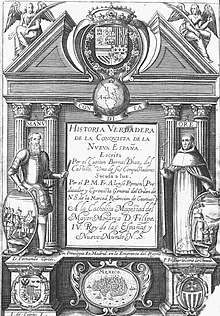Historia verdadera de la conquista de la Nueva España
 Title page of an edition of 1632 | |
| Author | Captain Bernal Diaz del Castillo |
|---|---|
| Original title | Historia verdadera de la conquista de la Nueva España |
| Translator | Maurice Keatinge |
| Country | England |
| Language | English |
| Subject |
Cortés, Hernán, -- 1485-1547. Mexico -- History -- Conquest, 1519-1540. |
| Published |
1800 (Printed for J. Wright, Piccadilly, by John Dean, High Street, Congleton) 1963 (Penguin Books) |
| Media type | |
| Pages | 514 |
| ISBN | 0-14-044123-9 (1963) |
| OCLC | 723180350 |
Historia verdadera de la conquista de la Nueva España (The True History of the Conquest of New Spain) is the first-person narrative written in 1576 by Bernal Díaz del Castillo (1492–1581), the military adventurer, conquistador, and colonist settler who served in three Mexican expeditions; those of Francisco Hernández de Córdoba (1517) to the Yucatán peninsula; the expedition of Juan de Grijalva (1518), and the expedition of Hernán Cortés (1519) in the Valley of Mexico; the history relates his participation in the fall of Emperor Moctezuma II, and the subsequent defeat of the Aztec Empire.
In the colonial history of Latin America, it is a vivid, military account that establishes Bernal Díaz del Castillo “among chroniclers what Daniel Defoe is among novelists”.[1] Late in life, when Díaz del Castillo was 84 years old and living in his encomienda estates in Guatemala, he wrote The True History of the Conquest of New Spain to defend the story of the common-soldier conquistador within the histories about the Spanish conquest of Mexico. He presents his narrative as an alternative to the critical writings of Bartolomé de Las Casas, whose Indian-native histories emphasized the cruelty of the conquest as well as the histories of the hagiographic biographers of Hernán Cortés (specifically that of Francisco López de Gómara, who Díaz del Castillo believed minimized the role of the 700 enlisted soldiers instrumental to conquering the Aztec Empire). That said, Díaz del Castillo strongly defended the actions of the conquistadors, whilst emphasising their humanity and honesty in his eyewitness narrative, which he summarised as this: "We went there to serve God, and also to get rich."
The history is occasionally uncharitable about Cortés; like other professional soldiers who participated in the Conquest of New Spain, Díaz del Castillo found himself among the ruins of Tenochtitlán only slightly wealthier than when he arrived to Mexico. That was common to many soldiers, who accused Cortés of taking more loot than his agreed fifth of the Aztec treasury. Certainly, the land and gold compensation paid to many of the conquistadores proved a poor return for their investment of months of soldiering and fighting across Mexico and the Anahuac Valley. Another interpretation of the book is that the author was one of several family relatives of Diego Velázquez de Cuéllar, the governor of Cuba and a mortal enemy of Cortés; many of whom later plotted against the conquistador Captain. Although the narrative minimizes the Cortés–Díaz del Castillo relationship, the author's complex relationship with Cortés and the lower captains suggests that although he represented the faction of Governor Velázquez de Cuéllar in the expedition, Díaz del Castillo fully honoured Cortés's personal and military loyalty.
Publication
- The True History of the Conquest of Mexico by Captain Bernal Diaz del Castillo, translated by Maurice Keatinge, London, 1800
- Penguin Books edition, 1963, ISBN 0-14-044123-9
Notes
- ↑ J.M. Cohen citing The Conquest of Mexico, by W.H. Prescott in The Conquest of New Spain J.M. Cohen, editor. London: Penguin Books, 1963. p. 9.
References
- Díaz del Castillo, Bernal (1963) [1632]. The Conquest of New Spain. Penguin Classics. J. M. Cohen (trans.) (6th printing (1973) ed.). Harmondsworth, England: Penguin Books. ISBN 0-14-044123-9. OCLC 162351797.
External links
- Historia verdadera de la conquista de la Nueva España. Tomo I, facsimile of 1939 edition, with introduction and notes by Joaquín Ramírez Cabañas, published Mexico City by Pedro Robredo; reproduced online at the Biblioteca Virtual Miguel de Cervantes (Alicante, Spain, 2005) (in Spanish)
- Historia verdadera de la conquista de la Nueva España, online reproduction by Biblioteca Virtual Antorcha, based on the 1961 Fernández Editores edition, published Mexico City (in Spanish)